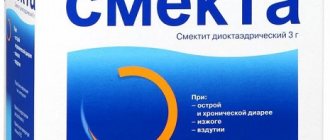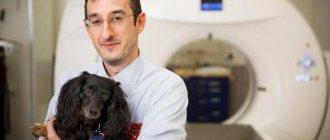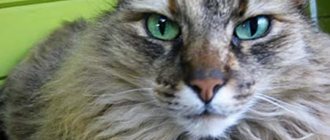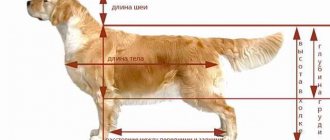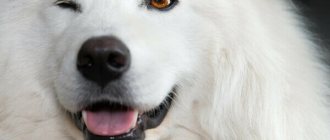Dysbacteriosis is a rather serious problem in cats, which you need to try to detect at an early stage and begin to treat in a timely manner. Otherwise, not only the intestinal microflora will suffer, but the entire body as a whole.
Dysbacteriosis is a disease that is quite difficult to detect at the first symptoms. In addition, the disease negatively affects the pet’s body as a whole, destroying its intestinal microflora and immune system.
Quite often, dysbiosis is confused with poisoning, which has the same symptoms. Therefore, at the first signs of the disease, it is better to immediately contact a specialist in order to identify the disease at an early stage and avoid serious consequences.
Dysbacteriosis in cats
Dysbacteriosis in cats is a disease characterized by a violation of the mobile balance of microflora that normally populates the intestines.
If in a healthy cat in the distal parts of the small intestine and in the large intestine lactobacilli, anaerobic streptococci, E. coli, enterococci and other microorganisms predominate, then with dysbacteriosis the balance between these microorganisms is disturbed, putrefactive, iodophilic or fermentative flora, fungi, mainly of the Gandida type, develop abundantly . With dysbacteriosis in cats, there are microorganisms in the intestines that should not normally be present; a large number of microbes and fungi are detected in the contents of the proximal parts of the small intestine and in the stomach. Instead of non-pathogenic strains of E. coli, pathogenic ones are often found in cats. Thus, with dysbiosis, quantitative and qualitative changes in the composition of microbial associations in the gastrointestinal tract of a cat are observed.
Etiology. Clinical dysbiosis in cats is caused by all diseases and conditions that are accompanied by disruption of the processes of hydrolysis and absorption of nutrients in the intestine - dyspepsia, gastritis (gastritis in cats), pancreatitis (pancreatitis in cats), hepatitis (liver disease in cats), enteritis, poisoning in a cat (Poisoning in a cat: first aid), colitis (colitis in cats), gastroenteritis (gastroenteritis in cats), worms in cats, severe stress, hormonal imbalance associated with pregnancy, the use of contraceptives (contrasex), infectious diseases - (feline panleukopenia , salmonellosis in cats, infectious peritonitis in cats, infectious rhinotracheitis - herpes in cats), parasitic (coccidiosis in cats, giardiasis in cats) kidney disease in cats, oncological diseases of the stomach and intestines (oncology in cats).
Often the cause of intestinal dysbiosis in cats is long-term uncontrolled use of antibiotics, sulfonamides, nitrofurans and other antimicrobial agents that suppress normal intestinal microflora and promote the development of those microorganisms that are resistant to these substances.
Pathogenesis. The mechanism of development of dysbiosis in cats is as follows: there is a disruption in the antagonistic activity of the intestinal microflora towards pathogenic and putrefactive microorganisms, its participation in the digestive processes (due to its own enzymes) and the synthesis of certain vitamins. Toxic waste products of microorganisms and the products of breakdown of nutrients formed in large quantities - organic acids, aldehydes, indole, skatole, hydrogen sulfide, histamine and others, irritate the intestinal wall. An allergic reaction occurs in the cat's body to unusual products of the breakdown of nutrients, as well as to antigens of bacteria and fungi.
Clinical picture. Dysbacteriosis in cats is characterized by clinical signs of dyspepsia or enteritis. The cat's appetite is reduced, and with severe spastic pain in the intestines it disappears completely (loss of appetite in the cat). An unpleasant putrid odor emanates from the mouth (bad breath in a cat), vomiting or the urge to vomit is possible (vomiting in a cat). Dysbacteriosis in cats is often accompanied by the development of intestinal flatulence (bloating in a cat). The cat's abdomen is sharply increased in volume, and upon palpation it is very tense and painful.
Diarrhea that occurs (diarrhea in a cat) may alternate with constipation (constipation in a cat (coprostasis). Feces have a sharp putrid or sour odor and contain undigested food particles. As a result of disturbances in the activity of the gastrointestinal tract, the cat experiences symptoms of general intoxication of the body - lethargy, apathy, depression.
With a long course of dysbacteriosis, it is complicated by hypovitaminosis, especially in the body there is not enough B vitamins.
Some types of intestinal dysbiosis, especially staphylococcal, candidomycosis, and proteus, can become generalized and even cause sepsis in the cat.
Diagnosis. To diagnose the disease in modern veterinary clinics, the following methods are used: biochemical blood test (cat blood test), fecal examination and endoscopic examination. The diagnosis of dysbacteriosis in cats is confirmed by repeated studies of fecal microflora (mainly based on the results of coprogram).
If gastrointestinal pathology is suspected, radiography and ultrasound of the abdominal cavity (ultrasound in a cat) are performed.
Differential diagnosis. Veterinary specialists, when carrying out differential diagnosis, must exclude dysbiosis that occurs against the background of systematic nutritional errors (established on the basis of the collected anamnesis) and dysbacteriosis accompanying acute and chronic infectious and invasive diseases.
Treatment. When dysbacteriosis is established in a cat, stop using antibacterial agents that contribute to its development. They carry out a set of activities aimed at:
- Purgation.
- Improving the functioning of the gastrointestinal tract.
- Restoration of beneficial microflora in the intestines.
- Immune support.
- Mental stabilization.
We cleanse the intestines of toxins and waste by prescribing enterosorbents (Smecta, Lignitin). Some veterinary specialists carry out intestinal cleansing by prescribing phytoelite: a tablet 4-5 times a day (first week) and 3 times a day (second week). In the third week, the dose is reduced to ½ tablet, which should be given once a day. In the last, fourth week of treatment, give 1 tablet once a week.
To improve the functioning of the digestive organs, we use enzymatic preparations - Mezim, Cholenzym.
If your cat has diarrhea, give rice decoctions.
In order to restore the population of beneficial microorganisms in the intestines, we treat with probiotics. Among the probiotics, veterinary specialists usually prescribe the following:
Lactobifid, Lactoferon, Fortiflora, Linex, Bifidumbacterin, Baktisubtil
These products should be used under the supervision of a veterinarian.
Among the antihistamines, cats are prescribed diphenhydramine, tavegil, trexil, suprastin, fenkarol, kestin, claritin, etc. in therapeutic doses.
Immunity support is carried out by using neoferon in the form of injections. This immunomodulator is administered subcutaneously or intramuscularly.
The treatment regimen is determined by a veterinarian. The herbal preparation “Cat Bayun” in tablets or in the form of an infusion will help stabilize the psyche.
The cat's feeding diet is prepared in such a way that a significant proportion of it consists of sour milk products: yogurt, acidophilus, bifidokefir, bifilife, bifidok, fermented baked milk, cottage cheese, etc.
In case of dysbacteriosis that has arisen against the background of an underlying disease of the digestive tract (enteritis, colitis, etc.), it is necessary to eliminate this pathology and restore the normal functioning of the stomach and intestines.
Prevention of dysbacteriosis.
In order to prevent dysbiosis in cats, animal owners should take the following preventive measures:
- Treat for helminthic diseases twice a year.
- Vaccinate against infectious diseases present in the region of residence.
- Timely detect and treat diseases of the gastrointestinal tract.
- After a course of antibiotic therapy for certain diseases of the digestive system, conduct a course of treatment with probiotics.
This disease was “invented” by Russian food manufacturers and pharmacists to sell products with pro- and prebiotics. There is no disease called “dysbacteriosis” in any international registry of diseases, but in Russia it is constantly found in infants and adults. Dysbiosis in cats has also been described.
Composition of intestinal microflora
Clostridia that live in the gastrointestinal tract of cats
The intestines of cats contain many clostridia (Clostridium perfringens), E. coli (Escherichia Coli) and streptococci. Microbial balance is normally regulated independently, without any outside interference.
The composition of intestinal microflora is influenced by various factors:
- method of preparing the diet (dry, canned or homemade food);
- feed composition (especially the amount of protein, dietary fiber and digestible carbohydrates);
- use of feed additives (for example, probiotics);
- functional viability of the digestive glands (pancreas, liver) and digestive tract.
What is dysbiosis
This term does not hide a disease, but a state of microbial imbalance, which often accompanies a serious illness. A healthy body is populated both inside and outside by many microorganisms called normal microflora. Dysbacteriosis, also known as dysbiosis, indicates that there has been a malfunction in the composition/function of microorganisms.
Microflora of the digestive canal
It is considered the richest (after the intestines) in both the number and quality of beneficial microorganisms. Thus, lactobacilli, strepto- and staphylococci, bifidobacteria, spirochetes, fungi of the genus Candida and protozoa live in the oral cavity. Microorganisms (in the form of a biological film) cover all mucous membranes and live in the digestive tract.
Microflora of the stomach
It is less representative (against the background of the same intestine), which is explained by the increased acidity of gastric juice. Found in the stomach:
- yeast;
- bacilli;
- lactobacilli;
- sarcins;
- acid-fast bacteria.
Microflora of the gastrointestinal tract
It consists of two groups of microorganisms - permanent and facultative. The first, more often called obligate, includes lactic acid bacteria, C. sporogenes, enterococci, C. petfringens and others that have adapted to living conditions. The second group includes microorganisms that change depending on various factors (food, regimen, and more).
The role of normal microflora
Bifidobacteria, lactobacilli, E. coli and other representatives of beneficial microflora living in us are responsible for the body’s immunity to infectious diseases. It has been proven that lactic acid bacteria are involved in the production of microcins - antibiotic components with a wide spectrum of action.
Important! In turn, lactobacilli, including L. plantarum, L. acidophilus and L. casein, suppress the growth of staphylococci, salmonella, Pseudomonas aeruginosa, listeria and other pathogens of severe infections.
In addition, the gastrointestinal microflora is recognized as an additional source of protein and is involved in the digestion of roughage in herbivores. Normal microflora inhibits the development of pathogenic/putrefactive processes and also participates in the production of vitamins.
Why is dysbiosis dangerous?
In our country, this term is usually used to describe intestinal dysbiosis. A 2003 Ministry of Health order described the disorder as “a syndrome in which a qualitative and/or quantitative change in the composition of the intestinal microflora has occurred.” The vital activity of microflora can be disrupted for various reasons, leading to dysbiosis and the development of serious pathologies.
Dysbiosis is often a companion to the inflammatory process in the intestines and even chronic fatigue syndrome. Modern cats suffer from dysbiosis no less than their owners. This is not surprising - animals move little, do not spend time in the fresh air and eat refined foods, which affects the functioning of the gastrointestinal tract.
Important! An imbalance of beneficial and pathogenic microflora, leading to dysbiosis, reduces immunity: it is known that up to 70% of the immune system is located in the intestines.
If you suspect that your cat's natural microflora is disturbed, take her to the doctor. In the early stages, dysbiosis often indicates the development of gastritis, gastroenteritis, hepatitis and allergies.
Causes of dysbiosis
There can be many of them, and they are not always of a physiological nature. Catalysts of dysbiosis in cats include factors such as:
- renal/liver failure;
- severe stress, such as moving or changing ownership;
- radiation exposure;
- hormonal disbalance;
- antibacterial therapy;
- improper conditions of detention;
- helminth infection.
Incorrect content
This is a common mistake of most owners, consisting of a number of shortcomings (stale air in the room or, conversely, constant drafts; frequent washing; poor food). Don’t count on a healthy pet by feeding it economy-class food that doesn’t contain the necessary minerals/vitamins. Such products are oversaturated with carbohydrates and fats, which provoke gastrointestinal ailments. Often cats stop accepting normal food and experience nausea and vomiting.
Hormonal disbalance
In this case, the culprits of dysbiosis are:
- pregnancy;
- age-related changes;
- weakened pancreas;
- hormonal contraceptives, including contrasex and gestrenol.
Long-term antibiotic treatment
This type of dysbiosis, which occurs after prolonged antibacterial therapy, is considered the most complex. After antibiotics, the normal microflora is replaced by occupier bacteria, characterized by insensitivity to a large number of medications.
Dysbacteriosis - causes
This disease is directly related to malfunctions of the microflora, and specifically, the replacement of good and necessary microorganisms with microbes. This problem is serious and can adversely affect all systems of the body. For what reasons does the disease occur?
- Improper care of your pet - low quality food, an excess of carbohydrate products in a natural diet, a deficiency of macro and microelements, as well as vitamins in food; excessive humidity (or vice versa dryness) and drafts in the room, systematic temperature changes in the home, very frequent water treatments.
- Dishormonal processes - physiology, pregnancy, lack of digestive enzymes produced by the pancreas, hormonal contraceptives.
- Diseases of the liver and kidneys with their impaired function.
- Anxious state (stress) – when the pet was frightened by someone, was alone for a long time or was betrayed, etc.
- Antibiotic therapy - such treatment almost always has consequences when “bad bacteria” (fungi, staphylococci, Pseudomonas aeruginosa, etc.) occupy a leading position in the cat’s body.
- Worm infestation.
The disease itself is not dangerous and is completely treatable, but if no action is taken for a long time, other, more serious diseases may appear, such as hepatitis, gastritis, gastroenteritis, all kinds of allergies, as well as pancreatitis.
Diagnosis and treatment
Making a correct diagnosis is not easy due to the symptoms, which often relate not to dysbiosis, but to other diseases.
Diagnosis
There is almost no doubt about the diagnosis if the cat has undergone a course of antibiotic treatment: in this case, dysbiosis is inevitable.
At the clinic, the animal is examined, including:
- blood biochemistry;
- pancreas/liver diagnostics;
- urine/stool test;
- smear for the presence of worms.
The main treatment begins after getting rid of helminths.
Therapy
Dysbacteriosis in cats can be cured in 1–2 months. During this time it is necessary:
- cleanse the gastrointestinal tract;
- restore microflora;
- normalize metabolism;
- support immunity;
- stabilize the psyche.
Drug treatment consists of a course of vitamins, the administration of antihistamines (relieving allergic manifestations, including swelling) and drugs that boost immunity. In case of dysbiosis, hormonal contrasex is prohibited. In case of severe symptoms, it is allowed to give activated carbon or smecta.
Cleansing the gastrointestinal tract
For this purpose, the doctor usually prescribes phytoelite: a tablet 4-5 times a day (first week) and 3 times a day (second week). In the third week, the dose is reduced to 1/2 tablet, which should be given once a day. In the last, fourth week of treatment, give 1 tablet once a week.
Restoration of microflora
The first thing to do is to put your pet on a light diet with a high proportion of fermented dairy products. This will help restore the microflora, populating it with lacto- and sour-lactic bacteria. In parallel with this, prebiotics (dietary fiber fermented in the intestines) should appear in cat dishes. They become a nutrient substrate for beneficial microorganisms that displace pathogenic bacteria.
Important! It has been established that a lot of fibers that are beneficial for the gastrointestinal tract are contained in Jerusalem artichoke, dandelions, asparagus and bananas. If your cat eats natural foods, crushed plants can simply be added to the food.
Lactoferon is given if it is prescribed by a veterinarian. Without his recommendations, taking the drug will only do harm.
Immune support
For this purpose, neoferon is prescribed in the form of a solution. The regimen, as well as the method of administering the immunomodulator (subcutaneously or intramuscularly), is determined by the doctor. If necessary, the course is repeated after a pause of 2–3 weeks.
Normalization of psychological background
The herbal preparation “Cat Bayun”, available in tablet and liquid (infusion) forms, helps relieve the animal from stress. This is a multi-purpose medicine based on herbs (valerian root, oregano, hawthorn, sweet clover, motherwort, lemon balm, mint, meadowsweet, nettle, thyme, St. John's wort, peony and others). The dosage and regimen is determined by the veterinarian.
Probiotics
In this category, normoflorins performed well, inhibiting “bad” microorganisms and saturating the intestines with “good” bacteria (capable of synthesizing vitamins B and K).
This is interesting! Do not give probiotics at your own risk until the necessary tests have been completed. A cat's intestines are colonized by millions of bacteria, and only a medical examination will determine which ones need to be replenished.
The drugs can be used not only for treatment, but also to prevent dysbiosis. The prophylactic dose is usually half the therapeutic dose.
Traditional methods
If there is accumulation of gas, the cat is recommended to use caraway or dill oil (3-5 drops throughout the day). Castor oil will help get rid of constipation. To normalize appetite, a herbal decoction of yarrow, dill, coriander and basil is used. The herbs are mixed in equal parts and poured with boiling water, after infusion, filtered and given to the cat 10 drops per day.
Treatment
To balance the intestinal microflora, there are two groups of drugs. Probiotics are live microbes, and prebiotics are food components that are a good nutrient medium for the development of the “right” microorganisms (inulin, pectin, dietary fiber).
Some doctors allow the use of human drugs for cats, others believe that they are useless and recommend only veterinary supplements. However, probiotics and prebiotics are almost never used as the only therapy. They are prescribed as an addition to the main treatment according to the principle “they will never harm.”
A veterinarian may prescribe a probiotic for a kitten that is lagging behind in growth and development, but at the same time recommends giving the baby an anthelmintic and testing for viral infections. Preparations for restoring microflora are used for diarrhea of any origin, but at the same time it is necessary to fight the root cause (antiprotozoal agents for giardiasis, sorbents for poisoning, and so on).
Prebiotics are included in commercial cat food, so there is no need to provide them additionally. Of the special prebiotic dietary supplements, the nutritious drink Viyo deserves attention - it is produced in the form of a liquid broth and thus increases water consumption.
Probiotics are used much more often. They can come in different forms. The drug Fortiflora from the company Purina is a powder, Lactoferon is produced in the form of tablets, and Multibacterin Omega 10, BF-15 is produced in the form of a liquid suspension. The composition of the products may vary, but most often they are lactic acid bacteria (Enterococcus faecium and others).
The effectiveness of all such drugs has not been proven, but also not refuted by large studies. They are definitely not harmful, but you shouldn’t expect “magical” healing from them. Although if you read the annotations, miracle bacteria are positioned as a universal remedy for a dozen diseases.
Prevention of dysbiosis in cats
Maintaining a healthy balance of intestinal microflora is easier than bringing it back to normal, especially if serious diseases have already been added to the dysbiosis.
The set of preventive measures looks like this:
- regular deworming of animals (even those who do not go outside) - domestic cats become infected with parasites through the owner’s clothes/shoes. Anthelmintics are used once every six months;
- adjusting the cat's diet - low-quality food sooner or later causes deviations in the activity of the gastrointestinal tract, associated with allergic manifestations;
- control of cat food - the impetus for the development of dysbacteriosis is often synthetic materials (sausage casing, fragment of film) that accidentally get into food;
- taboo on the uncontrolled use of antibiotics - these medications should be used as a last resort if other medications have been ineffective;
- introduction of pro- and prebiotics into the diet if the cat is undergoing or has undergone a course of treatment with antibiotics.
It will also be interesting:
- Vomiting in a cat
- Asthma in a cat
- Mycoplasmosis in cats
- How to give injections to a cat correctly
A course of therapy, which includes probiotics with lacto- and bifidobacteria, is recommended for cats of so-called “artificial” breeds and animals with a tendency to dysbiosis.
What it is
Pet nutrition consists of more than just special food. A pet's diet, just like a person's, may contain refined food, which has a negative effect on the functioning of the stomach.
Cats often suffer from a sedentary lifestyle. This negatively affects the functioning of the gastrointestinal tract, resulting in an imbalance of pathogenic and normal microflora. This affects the general condition of the animal.
What is dysbiosis and what causes it?
Dysbacteriosis (dysbiosis) is not a separate pathology, but a broad term denoting the replacement or death of bacteria that form the natural normal microflora. Their place is filled by pathogenic bacteria and E. coli and begin to develop rapidly.
The process involves all body systems, mucous membranes and muscles.
Factors that provoke dysbacteriosis include:
- Poor living conditions (unbalanced diet, vitamin deficiency, predominance of fats and carbohydrates in food, insufficient indoor air humidification, drafts, dry low-quality food, etc.).
- External reasons (change of residence, unfavorable environmental conditions).
- Disorders of the hormonal system, which can be caused by pregnancy, taking medications (including contraceptives).
- Liver, kidney failure.
- Psycho-emotional stress. Stress can be associated with a change of owners, the appearance of another pet in the house, the loss of offspring and other factors that negatively affect the animal’s psyche.
- Long-term, repeated antibiotic therapy is the most severe case of dysbiosis. As a rule, even one course of antibiotics is harmful to the animal. As a result, normal microflora is replaced by pathogenic microorganisms that are resistant to the effects of medications.
- Worm infestation.
Dysbacteriosis can develop in any animal. Artificially bred cat breeds are most susceptible to this condition - Scottish, British, etc.
Why is dysbacteriosis dangerous? To answer this question, you need to understand what function the intestinal microflora performs. This is a kind of protective barrier that protects the body from the effects of pathogenic bacteria, fungi, and viruses.
In addition, it stimulates and activates the immune system in kittens, neutralizes and removes toxins from the body, regulates metabolism and the activity of the hormonal system.
If signs of dysbiosis are detected, it is necessary to contact a veterinarian as soon as possible, otherwise the pet’s body will be completely defenseless against pathogenic microorganisms that cause dangerous diseases.
The difficulty of diagnosing pathology is that dysbiosis skillfully disguises itself as other diseases.
To confirm or refute the diagnosis, the veterinarian needs to conduct a number of studies: urine and feces analysis, blood biochemistry, smear for the presence of helminths, checking the liver and pancreas.
Symptoms
Signs of pathology appear suddenly. The cat looks depressed, sick, and shows no activity. Appetite is absent or reduced, causing the animal to lose weight. The stool is liquid, sometimes with mucus and blood. There may be both diarrhea and constipation.
The wool loses its shine and does not look aesthetically pleasing. In representatives of long-haired breeds, the fur coat may thin out significantly.
In some cases, bloating and flatulence are observed. Such a clinical picture gives every reason to suspect dysbiosis, especially if the cat was recently treated with antibiotics.
If the diagnosis of dysbacteriosis is confirmed by laboratory tests, then do not panic. This phenomenon is not very pleasant and it creates a certain danger for the body. However, the pathology is not transmitted to other animals and humans, is successfully treated and does not cause complications.
Therapy lasts 1-2 months and is complex. Treatment is aimed at:
- cleansing the gastrointestinal tract;
- restoration of natural microflora;
- normalization of metabolism;
- strengthening the immune system;
- stabilization of the psycho-emotional background.
If the symptoms are pronounced, the cat is given activated charcoal, Smecta. In general, drug treatment includes vitamin therapy, antihistamines, and drugs that strengthen the immune system. Hormonal pills, including contraceptives, are prohibited!
Cleansing of the gastrointestinal tract is carried out using the drug “Fitoelita”. The dosage is determined individually by the veterinarian.
To restore the microflora, the pet is prescribed a special light diet. The diet consists of fermented milk products. Such nutrition restores microflora. The colonization of lacto- and sour-lactic bacteria has a beneficial effect on the gastrointestinal tract.
Prebiotics will become a nutrient substrate for beneficial microorganisms that displace pathogenic bacteria. They should also be in the diet. It is advisable to include foods such as bananas, asparagus, and Jerusalem artichoke in the cat's menu. Of course, it is unlikely that the fluffy will show interest in such food, but it is still worth adding them little by little to dishes.
Lactoferon is used only if it is recommended by a specialist.
To strengthen the immune system, a solution of Neoferon is indicated, which is administered intramuscularly or subcutaneously.
It is very important to help your cat cope with stress, for which she is given sedatives. The herbal preparation “Cat Bayun” has proven itself well. The composition includes mint, meadowsweet, sweet clover, motherwort, valerian root, St. John's wort, etc.
As for probiotics, normoflorins are mainly used. They effectively destroy pathogenic microorganisms and saturate the intestines with beneficial bacteria, renewing the biosynthesis of vitamins B1, B2 and K. In addition, probiotics promote the formation of acetic and lactic acids, which promote good absorption of vitamins, iron, and fats.
Do not underestimate the seriousness of dysbiosis. If left untreated, cats may develop gastritis, pancreatitis, gastroenteritis, allergies, hepatitis, and respiratory diseases along with the death of microflora. If treatment was carried out promptly and competently, the prognosis is usually favorable.
Excessive bacterial growth in the intestine: pathogenetic features and therapeutic approaches
IN
The human gastrointestinal tract is home to many bacteria, which, in fact, are symbionts of their “host”. As paradoxical as it may sound, the “host” organism needs microbial inhabitants just as much as they need its support.
The main part of microorganisms enters the lumen of the gastrointestinal tract from the oropharynx and with food.
More than 400 species of non-pathogenic aerobic and facultative anaerobic bacteria have been identified as part of the normal microflora of the gastrointestinal tract.
The intestinal biocenosis also includes a small number of conditionally pathogenic organisms, forming the so-called “residual population”: staphylococci, fungi, Proteus, hemolytic strains ( E.coli)
.
The composition of the microflora is not the same throughout the gastrointestinal tract. In the upper and middle sections of the small intestine, the population of microorganisms is relatively small (at the beginning of the jejunum their content is no more than 100 microorganisms per 1 ml of contents) and includes predominantly gram-positive facultative aerobes, a small number of anaerobes, yeasts and fungi.
As you approach the ileocecal valve, the composition of the microflora begins to more and more resemble the population of the large intestine. In the distal ileum, the microbial content is 105–108/g of intestinal contents.
The highest content of microorganisms is observed in the large intestine. Here their concentration reaches 1010–1011 or more per 1 g of content.
The large intestine is home to the bulk of anaerobic microorganisms. The “main population” (about 70%) consists of anaerobes - bifidobacteria and bacteroides. Lactobacilli, Escherichia coli, and enterococci act as “concomitant populations.”
Bacteria inhabiting the lumen of the gastrointestinal tract perform a number of functions that are very important for the “host” organism.
The microbial population plays a critical role in intraluminal digestion, in particular, it participates in the digestion of dietary fiber (cellulose), the enzymatic breakdown of proteins, high-molecular carbohydrates, fats, and in the process of metabolism produces a number of substances beneficial to the body.
The main representative of anaerobic intestinal microflora is bifidobacteria
– synthesize amino acids, proteins, vitamins B1, B2, B6, B12, vikasol, nicotinic and folic acids. It has been suggested that some substances produced by bifidobacteria have antioxidant properties and help reduce the risk of colon cancer.
Among aerobic microorganisms, the most important role in metabolic processes belongs to Escherichia coli, which has a wide range of functional properties. E. coli
produces several vitamins (thiamine, riboflavin, pyridoxine, vitamins B12, K, nicotinic, folic, pantothenic acids), participates in the metabolism of cholesterol, bilirubin, choline, bile and fatty acids, and indirectly affects the absorption of iron and calcium.
The products of protein metabolism (indole, phenol, skatole) formed under the influence of microphora have a regulating effect on the peristaltic activity of the intestine.
Recently, the role of intestinal microflora in the formation of immunological reactivity and immunological tolerance of the body has been intensively studied.
Representatives of normal intestinal microflora produce substances with antibacterial activity (such as bacteriokines and short-chain fatty acids, lactoferrin, lysozyme), which prevent the introduction of pathogenic microorganisms and suppress the excessive reproduction of opportunistic flora. Escherichia coli, enterococci, bifidobacteria and lactobacilli have the most pronounced antagonistic properties against pathogenic strains.
The metabolic products of lactic acid bacteria (bifidobacteria, lactobacilli) and bacteroides are lactic, acetic, succinic, and formic acids. This ensures that the pH of the intestinal contents is maintained at a level of 4.0–3.8, thereby inhibiting the growth and reproduction of pathogenic and putrefactive microorganisms in the gastrointestinal tract.
Initially limited ideas about the “local” protective role of intestinal microorganisms have expanded significantly in recent years. Microbiologists and immunologists emphasize the importance of continuous “communication” between the “host” organism and its symbionts. Through contact with the microbial population through the mucous membrane and the constant penetration of a small amount of bacteria, their antigens and metabolic products into the bloodstream, the necessary tension of the immune system is maintained, including, probably, the “tone” of antitumor defense is maintained.
The microflora of the gastrointestinal tract is actively involved in the chemical transformations of many substances of endogenous and exogenous origin, in particular drugs. During the enterohepatic circulation, substances passing from the intestinal lumen to the liver undergo conjugation with glucuronate, sulfate and other molecular residues, and many of them are then excreted again in the bile. In the intestinal lumen, under the influence of enzymes of the intestinal microflora, they undergo deconjugation and other changes, after which they are reabsorbed and returned to the liver through the portal vein.
Mechanisms for maintaining normal “microbial balance” in the lumen of the gastrointestinal tract and inhibiting microbial growth include protective factors of the mucous membrane (bactericidal properties of gastric hydrochloric acid, production of mucus and antibodies, mainly belonging to the classes of immunoglobulins A and M), as well as normal peristaltic intestinal activity, during which some bacteria are regularly removed into the external environment. The integrity of the brush border of enterocytes also acts as an important element of protection, since it acts as a “bacterial filter” that prevents contact of bacteria with the cells of the mucous membrane.
The quantitative and qualitative composition of the intestinal microflora can change under the influence of various factors of endogenous or exogenous origin. However, this change should be considered secondary to the underlying factor.
Bacterial overgrowth in the intestines
(in English-language literature -
bacterial overgrowth
) - is caused by a violation of the qualitative and quantitative composition of the intestinal microbial biocenosis, the proliferation of opportunistic bacteria in quantities not typical for a healthy person. We must not forget that bacterial overgrowth in the intestines and associated clinical manifestations are not an independent nosological form, but a syndrome.
It is not entirely correct to use the outdated term “dysbacteriosis”, since this name does not fully reflect the essence of developing disorders.
From a microbiological point of view, excessive bacterial growth is manifested by a significant decrease in the number of anaerobic representatives (especially bifidobacteria), an increase in the total number of functionally defective E. coli (“lactose”-, “mannitol”-, “indole-negative”), the content of hemolytic forms of E. coli, the creation conditions for candida reproduction.
The background for the development of bacterial overgrowth syndrome is various conditions accompanied by impaired digestion of food and passage of intraluminal contents; changes in the immunological reactivity of the body, iatrogenic effects on the intestinal microflora.
In various conditions accompanied by impaired digestion and absorption of food (congenital enzyme deficiency, pancreatitis, celiac enteropathy, enteritis), unabsorbed nutrients serve as a breeding ground for the excessive proliferation of bacteria.
Violation of the passage of intraluminal contents is observed with the formation of interintestinal fistulas, surgical interventions with the formation of “blind loops” of the intestine, the development of diverticula, impaired motor activity of the intestine (constipation or diarrhea), intestinal obstruction (obstructive or paralytic). These conditions also create favorable conditions for disturbing the “bacterial balance.”
In anacid conditions and immunodeficiencies, the body's regulatory influence on maintaining the composition of the intestinal microflora is lost.
The use of antibiotics, corticosteroids, and cytostatics, especially in weakened and elderly patients, is accompanied by interference in the relationship between the microflora and the macroorganism.
Perhaps the only independent nosological form of bacterial overgrowth in the intestine is pseudomembranous colitis
, which is caused by the excessive proliferation
of Clostridium difficile
, an obligate anaerobic gram-positive spore-forming bacterium that is naturally resistant to most commonly used antibiotics.
The population of C. difficile
in the normal intestinal microflora is approximately 0.01–0.001%;
it increases significantly (up to 15–40%) when taking antibiotics that inhibit the growth of strains of intestinal flora that normally suppress the vital activity of C. difficile
(primarily clindamycin, ampicillin, cephalosporins).
Bacterial overgrowth syndrome is characterized by various clinical manifestations, “layered” on the manifestations of the underlying disease.
Excessive proliferation of bacteria in the small intestine is an additional factor that maintains inflammation of the mucous membrane, reduces the production of enzymes (mostly lactase) and aggravates the disturbance of digestion and absorption. These changes cause the development of symptoms such as colicky pain in the umbilical region, flatulence, diarrhea, and weight loss.
When the colon is predominantly involved in the process, patients complain of loose stools, flatulence, and aching abdominal pain.
Severe imbalances in the composition of the intestinal microflora may be accompanied by signs of hypovitaminosis B12, B1, B2, B3 (PP). The patient has cracks in the corners of the mouth, glossitis, cheilitis, skin lesions (dermatitis, neurodermatitis), iron and B12 deficiency anemia. Since the intestinal microflora is an important source of vikasol, blood clotting disorders may occur. In some cases, as a result of a violation of the exchange of bile acids, symptoms of hypocalcemia develop (numbness of the lips, fingers, osteoporosis). A number of authors associate cholesterol metabolism disorders with disturbances in the “microbial balance” of the gastrointestinal tract.
Diagnosis of bacterial overgrowth syndrome
involves analyzing the picture of the underlying disease, identifying the possible cause of the disturbance in the intestinal microbial biocenosis. An additional examination is carried out, which may include endoscopic and x-ray examination of the intestines to identify disorders of the anatomical structure and assess the motility of the gastrointestinal tract; biopsy of the small intestine - to establish a diagnosis of enteritis, enteropathy, diagnosis of fermentopathy (unfortunately, the possibilities of conducting this study in our country are limited), etc. Little available today, but accurate methods for diagnosing excessive bacterial growth are aspiration of the contents of the small intestine with immediate culture aspirate to culture medium, as well as a non-invasive hydrogen breath test with lactulose. Stool culture, previously used in our country as a method for assessing the microbial biocenosis of the intestine, is considered uninformative, since even with the maximum approximation to the rules for conducting microbiological studies, it can only give an idea of the microbial composition of the distal colon.
Before directly starting to treat bacterial overgrowth syndrome, it is necessary to determine the cause of the development of disturbances in microbial biocenosis and, if possible, eliminate the influence of this factor. For example, prescribe the patient anti-inflammatory, enzyme replacement therapy, and use opportunities to normalize intestinal peristaltic activity.
Changing your diet
allows you to influence microflora physiologically. However, dietary prescriptions must be given taking into account the underlying disease. In any case, with excessive bacterial growth in the intestines, it is recommended to limit the consumption of easily digestible carbohydrates and eliminate the consumption of milk (especially unleavened milk). In the absence of contraindications, it is advisable to consume vegetables, fruits and berries that have a bactericidal effect (radishes, radishes, onions, garlic, horseradish, carrots, raspberries, strawberries, strawberries, blueberries, apricots, apples, chokeberries, pomegranate juice, cloves, cinnamon, bay sheet).
The outdated approach of “sanitizing and repopulating the intestines” does not correspond to modern ideas about the pathogenesis of bacterial overgrowth.
However, in severe forms of bacterial overgrowth in the intestines, antibiotic therapy
(prescription of metronidazole 400 mg 3 times a day for a week; if metronidazole is ineffective, it is advisable to add tetracycline 250 mg 4 times a day to treatment for 2 weeks). Reserve antibiotics are ciprofloxacin (500 mg 2 times a day) and vancomycin (125 mg 4 times a day). Treatment of pseudomembranous colitis is carried out according to certain schemes and is not discussed in this article due to the isolation of this disease.
In some cases, to suppress opportunistic microorganisms, bacteriophages (staphylococcal and coli-proteus) are used, 50 ml 2 times a day an hour before meals for 3-4 days, 2-3 courses are carried out with a 3-day break.
No less important and, often, the main direction of treatment is to recreate conditions favorable for the restoration of normal microflora. Medicines with similar properties are called probiotics
.
Some time ago, biological preparations for oral administration containing bifidobacteria, lactobacilli, and E. coli with beneficial properties were especially widely used as probiotics. It must be taken into account that microbes introduced as part of medications do not take root in the intestines for a long time and are eliminated after 2-3 weeks. The basis for the therapeutic effect of such drugs is their ability to temporarily maintain the enzymatic activity and protective properties (colicinogenicity) of the intestinal microflora. Some of the most well-known drugs are described below.
"Colibacterin" contains a suspension of live bacteria of the E. coli
M-17, which has antagonism towards opportunistic and pathogenic microflora. Prescribe 6-10 doses in 1-2 doses 40 minutes before meals for 3-4 weeks.
"Bifidumbacterin" contains a strain of bifidobacteria that are resistant to antibiotics. Prescribe 5-10 doses per day in 1-2 doses for 2-3 weeks. "Bifidumbacterin" acts most favorably if the patient has constipation.
"Bifikol" - a combination of co-grown E. coli
M-17 and bifidumbacteria. 6–10 doses are prescribed per day.
Lactobacterin is made from lactic acid bacteria. The microbes that make up this drug are highly resistant to antibiotics. Lactobacilli effectively inhibit the growth of Proteus and hemolytic strains of staphylococcus and support the growth of the E. coli
. Use 3–6 doses per day. Dairy products containing a culture of lactic acid bacteria similar to that included in Lactobacterin - acidophilic yeast curd and acidophilic milk, as well as the biomass of acidophilic lactobacilli called "Narine" - also have therapeutic and preventive activity.
Currently, the drug Enterol, which contains lyophilized medicinal yeast Saccharomyces boulardii,
that are naturally resistant to antibiotics.
S. boulardii
does not colonize the digestive tract and is eliminated in the feces within a few days after completion of therapy. They produce proteins that prevent the binding of pathogenic microorganisms and their toxins to the intestinal mucosa; stimulate the protective properties of the mucous membrane.
Favorable conditions for the proliferation of bifidobacteria are created by the disaccharide lactulose, which also has laxative and ammonium-binding properties. It serves as a breeding ground for the proliferation of lactic acid bacteria and a source for their production of lactic acid, which reduces the pH of the intestinal contents. Significant disadvantages of lactulose include the frequent development of bloating and diarrhea with loss of electrolytes (therefore, the administration of lactulose is preferable to patients suffering from constipation). Lactulose is contraindicated in galactosemia. The dose of lactulose syrup for adults varies from 15 to 45 ml per day (in 2-3 doses).
There is another, completely original, approach to normalizing the environment in the intestinal lumen, which helps restore the normal population of its “inhabitants”. This direction of pharmacological correction of bacterial overgrowth is represented by the drug “Hilak-Forte”
.
The drug "Hilak-Forte" is a sterile concentrate of biologically active substances produced by normal intestinal microflora (both gram-positive and gram-negative). Among them are lactic acid and short-chain volatile fatty acids (which have antibacterial properties against opportunistic and pathogenic flora), lactic-saline buffer, lactose, and amino acids. Just one drop of concentrate contains the biosynthesis products of 100 billion intestinal bacteria.
"Hilak-Forte" allows you to create favorable conditions for the proliferation of lactic acid bacteria
(by reducing pH, restoring water and electrolyte balance in the intestinal lumen and suppressing competitive flora). Interestingly, the effect of the drug is not limited to the effect on the bacterial composition, but also stimulates the regeneration of the epithelium of the intestinal mucosa.
“Hilak-Forte” is indicated for a wide variety of conditions accompanied by a violation of the “microbial balance”: disorders of maldigestion and malabsorption of various origins, disturbances of intestinal peristaltic activity, during the recovery period after acute infectious enterocolitis, etc. Prescribing "Hilak-Forte" is advisable during treatment with antibiotics and for some time after their discontinuation to prevent disturbances in the composition of the intestinal microflora.
"Hilak-Forte" is characterized by high efficiency and good tolerability. No contraindications to the use of the drug or side effects were identified. it can be prescribed not only to adults, but also to infants.
"Hilak-Forte" is taken orally before or during meals, diluted with a small amount of liquid (not an alkaline reaction!).
The initial dose for adults is 40–60 drops 3 times a day; for children – 20–40 drops 3 times a day; for infants – 15–30 drops 3 times a day. As clinical improvement occurs, the dose may be reduced by half.
"Hilak-Forte" cannot be taken at the same time of day with antacid drugs and adsorbents, since antacids neutralize, and adsorbents reduce the bioavailability of the acids that make up the drug.
When diagnosing a patient with bacterial overgrowth syndrome, it is necessary to understand the main thing in correcting this condition - not to aggressively interfere with microbial bicenosis, but to “lend a helping hand” to the microbes that ensure our health and well-being.
References:
1. Woodley M., Whelan A., eds. Washington University Therapeutic Handbook. Per. from English – M.: Praktika, 1995.
2. Grebenev A.L., Myagkova L.P. Intestinal diseases. – M.: Medicine, 1994.
3. Denisov I.N., Kulakov V.I., Khaitov R.M., Ch. ed. Clinical recommendations for practicing physicians based on evidence-based medicine. – M.: GEOTAR-MED, 2001.
4. Ivashkin V.T., Komarov F.I., Rapoport S.I., eds. A short guide to gastroenterology. – M.: Publishing house “M-Vesti”, 2001.
5. Kotelnikov G.P., Yakovlev O.G., eds. Practical geriatrics: A guide for doctors. – Samara: Samara Printing House, 1995.
6. Fauci AS, Braunwald E, Isselbacher KJ et al., ed. Harrison's Principles of Internal Medicine. 14th edition – Copyright (c) 1998 by The McGraw–Hill Companies, Inc., USA.
7. Herfindal E.T., Gourley D.R., ed. Textbook for therapeutics: drug and disease management – 6th ed. – Copyright (c) 1996 Williams & Wilkins, Baltimore, USA.
Symptoms and treatment of dysbiosis in cats
It turns out that cats are excellent at hiding their poor health, and even the most caring owners will not always be able to determine at first glance whether their pet is healthy or not. The presence of dysbiosis in cats is characterized by negative changes in the microflora. If the problem is neglected and timely treatment is not started, the microflora may completely die. Any disturbances cause active growth of bacteria that disrupt the functioning of organ systems. Dysbacteriosis is not only problems associated with the lack of beneficial bacteria, it is also disturbances in the functioning of the stomach and intestines, which causes an imbalance in the entire body as a whole. How can you protect your beloved pet from this?
Diagnosis of dysbacteriosis
There are no specific signs of dysbiosis in cats. It is suggested for any digestive disorders:
- diarrhea, loose stools, or constipation;
- flatulence (bloating of the intestines due to increased gas formation);
- periodic vomiting;
- poor skin and coat condition.
If a veterinarian suggests taking a stool test for dysbacteriosis, the patient has the right to doubt his prescription. Firstly, a healthy cat's feces will always contain a large number of anaerobic bacteria (1012 bacteria/gram or more). Secondly, bacteria outside the intestine begin to actively die, and the sample must be delivered to the laboratory for analysis no later than 2 hours after defecation.
Doctors often prescribe a general stool test. It can be used to identify undigested food debris, mucus, and hidden blood. The catch is that a “bad” coprogram in a healthy animal is an excuse to prescribe unnecessary drugs just in case (the same lactobacilli), but in a sick cat the coprogram will not clarify the diagnosis.
But tests that can reveal the true cause of digestive disorders will be very useful:
- PCR for viral infections;
- analysis for protozoa (giardiasis);
- clinical and biochemical blood tests;
- panoramic ultrasound of the abdominal cavity.
If doctors find it difficult to make a diagnosis, they may even recommend gastroscopy or colonoscopy. During these procedures, a sample of the contents of the digestive tract or a piece of tissue may be taken for histological examination (biopsy).
What is a disease
First of all, this is a disease that is difficult to detect with the naked eye. Secondly, this disease has a detrimental effect on the animal’s body and intestinal microflora, and also destroys the immune system.
Often, dysbiosis is similar to ordinary poisoning, which is accompanied by a lethargic state of the cat. Only experienced breeders can determine the presence of the disease without medical intervention.
The role of microflora in the body
What is microflora and why is it necessary to care about its quality?
In the body of every living creature, microflora performs important protective functions. The main task of microflora is to protect a specific organ from invasion and further proliferation of microbes. It is also directly involved in the biosynthesis of certain vitamins and in other processes that occur in the body.
After birth, the kitten acquires microflora characteristic of the environment in which it lives; it also depends on the state of its health and immunity. However, this does not mean that the microflora is acquired once and for all. During life, its composition constantly changes depending on the conditions of detention, age, and so on. Dysbacteriosis in a kitten develops much less frequently than in adult cats, because after birth, the animal is still sterile.
The role of normal intestinal microflora
The main task of beneficial microflora is as follows:
- normalize metabolic processes in the body;
- trigger the immune defense mechanism in a kitten that has just been born;
- produce necessary vitamins.
In the body of a newborn kitten, beneficial microflora is formed, characteristic of the environment in which the pet lives. Her condition will depend on the body’s defense system and overall health.
The microflora does not remain constant; it is influenced by various factors: age, living conditions, etc.
As the disease develops, an imbalance occurs, which negatively affects health. Infections are resisted by the intestines and the lactic acid bacteria living in it. For this reason, when the disease develops, the entire body is at risk.
In animals that have recently been born, the disease is much less common compared to adults, because kittens retain the immunity received from their mother.
Causes of the disease
The causes of dysbiosis may be the following:
- Moving to another place of residence, violating the rules of keeping an animal, which includes harmful, low-quality food, lack of vitamins, humidity, room temperature and any other factors that can lead to serious stress, which will trigger the disease.
- Pathologies such as kidney and liver failure, hormonal imbalances. For example, pregnancy in a cat, age characteristics, use of hormonal drugs. Hormonal contraceptives are prohibited for pets with dysbiosis; in case of severe symptoms, animals are prescribed activated charcoal or smecta.
- Stressful situations, such as fear caused by certain circumstances or other animals, starvation, long absence of owners, and so on.
- Long-term treatment with antibiotics. Experts note that even one course of medication can cause serious harm. If the course continues for a long time, then the microflora is “populated” with harmful bacteria. This dysbacteriosis is difficult to treat and represents the most severe form of the disease.
- Damage to the body by worms.
Possible reasons
Veterinary clinic specialists identify many predisposing factors that could trigger a problem in an animal:
- Changing of the living place.
- Improper maintenance and care of the pet.
- Poor quality food that does not contain the required amount of vitamins.
- Inconsistency between temperature and humidity in the room.
All these reasons can provoke a serious stressful situation, against the background of which dysbiosis develops.
Diseases such as liver or kidney failure and hormonal disorders also play an important role. These include:
- period of gestation;
- age of the animal;
- use of hormone-based drugs.
If there is dysbacteriosis, cats should not be given hormonal contraceptives. If the clinical picture is pronounced, then experts prescribe Smecta or activated carbon to the animal.
Intestinal dysbiosis can be provoked by factors such as fright, prolonged absence of food, or the pet being left alone for a long time..
The development of the disease is also possible after long-term use of medications.
According to most experts, a course of antibiotic treatment can pose a serious threat to a pet's health. If therapy lasts for a long time, then the microflora becomes colonized with pathogenic bacteria, because beneficial microorganisms die.
Symptoms of the disease
Only an experienced veterinarian can identify the symptoms and prescribe treatment for dysbiosis in a cat, because the first signs of the disease are in many ways similar to many other pathologies.
The main signs of the disease include the following:
- apathy and lethargy in the pet’s behavior, even the most active individuals become passive;
- complete lack of appetite, when the most favorite delicacies do not evoke the desire to eat;
- loose stools, with drops of blood or other intestinal disorders;
- the most obvious external signs are dull fur, bloated belly, dry skin, peeling, skin rash;
- dehydration and flatulence.
Treatment of the disease
In order to determine how to treat a cat, you should discard other diseases with similar symptoms. If your pet has previously undergone a long course of treatment, then after antibiotics dysbiosis is virtually inevitable.
If dysbacteriosis is suspected, the pet should immediately change its diet. In such cases, preference is given to dairy products and other light foods. Treatment of dysbiosis is impossible without complete vitamin complexes and enzymes that restore microflora.
An important fact is that dysbiosis in cats is safe for the human body, so help should be provided to your pet immediately. Experts recommend following the following rules:
- First of all, care should be taken to create conditions in which the microflora will recover and maintain these conditions in the future. This happens mainly due to bacteria that previously died from exposure to microbes.
- Cleanse the cat's body of toxins and waste.
- The issue of the lack of the right bacteria is solved by therapy, which is carried out with the help of probiotics.
- We must not forget about vitamin complexes, which are important for stimulating immune defense.
- Patience and painstaking work - therapy takes a long period and, as a rule, it lasts about two months.
Preventive measures
In order to prevent a deplorable situation and not expose your cat to unpleasant misfortunes, you can follow certain preventive rules that minimize the risk of dysbacteriosis. Don't forget that sincere love and care are the most important things required from an owner.
- You should choose food for your pet carefully - make sure that the food contains all the essential vitamins and microelements. Don’t forget that cats are big fans of picking up fallen food from the floor; it is also not recommended to allow this to happen. Dysbacteriosis can occur not only due to poor-quality food, but also from swallowed inedible small objects.
- You should be careful when treating with antibiotics. As practice shows, some diseases can be cured without the use of such serious drugs. If the situation forces you to use antibiotics, then you should definitely take care of restoring both the body and the cat’s microflora.
- Periodically it is worth carrying out prophylaxis with probiotics, bifidobacteria and lactobacilli. This therapy is absolutely safe for your pet. But the improvement of metabolism and the state of microflora will improve significantly.
Symptoms of SIBO
The symptoms of bacterial overgrowth are very similar to those of irritable bowel syndrome. This:
- pain and discomfort in the abdominal area
- bloating, flatulence
- diarrhea
- general weakness
- weight loss
- steatorrhea (“fatty stool”)
Symptoms occur because bacteria produce toxins, damage the lining, and change the pH in the small intestine. This interferes with the normal functioning of digestive enzymes in the intestinal lumen, complicates and disrupts the absorption of nutrients. Doctors call these processes the scientific terms maldigestion and malabsorption.
